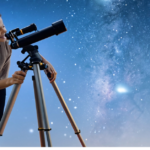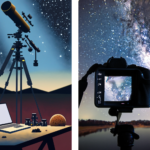Table of Contents
Photographing the night sky in amazing detail is only possible with the correct equipment and tools. A tripod for astrophotography is one of the most important pieces of equipment you’ll buy, a high-quality tripod will help you to produce the best results.

Astrophotography requires a sturdy tripod because it provides your camera with a stable base, which is vital for getting clear, sharp photographs of the many objects in the sky. Also, a sturdy tripod can make it simpler for you to change your camera’s settings and focus as well as assist you in acquiring the ideal angle and composition for your photo.
What are the essential qualities of a tripod for astrophotography?
Weight
Because you frequently have to transport your tripod to nearby areas, weight is a crucial factor in astrophotography. Although it may not be as solid as a heavier tripod, a lightweight one is generally easier to carry. A heavy tripod, on the other hand, might be more sturdy; however, it may be harder to carry around.
For astrophotography, stability is essential because even the smallest movement can produce blurred photos. Look for a tripod that offers your camera a stable foundation, regardless of how windy it is. The mirror or shutter movement in your camera can also cause vibrations, which can be minimised by using a solid tripod.
Usefulness
A tripod for astrophotography should be simple to set up and adjust, even in dim lighting. Choose a tripod with easy-to-use features that let you easily change your camera’s height, angle, and orientation.
Height
Another critical factor for astrophotography is the tripod’s height. To avoid bending or crouching while adjusting your camera’s settings or looking through the viewfinder, you should opt for a tripod set to a comfortable working height. A taller tripod, however, might be more difficult to carry.
Check the compatibility of the tripod you choose with your camera and lens. Be sure the tripod can hold the weight of your camera and equipment by checking its weight capacity. The best tripod for astrophotography would be one that can be used with either a camera or a small telescope. Remember that in this case, your tripod will be used when you do untracked astrophotography.
Even the best budget tripod for astrophotography may be enough if your camera and lens are not heavy, but the better quality you buy, the better in the long term. Learn more about the kinds of astrophotography you will be able to do with your new tripod.
Use the correct techniques while setting up your tripod once you’ve chosen a suitable model.
The following advice will help you make the most of your astrophotography tripod:
Choose a flat surface
When mounting your tripod, use a solid surface that won’t move or shake. A tripod may sink or lean if it is placed up on soft or uneven ground, so avoid doing this.
Fully extend the legs
Fully extend the legs of your tripod and lock them in position for maximum stability. If the tripod’s height needs to be adjusted, do it by changing the central column rather than by lowering the legs.
Use a bubble level to ensure that your tripod is level, which is necessary for capturing sharp, clear images. Most tripods come with a built-in bubble level, but you can also use a separate level if needed.
Using a remote shutter release or intervalometer is a good idea because even the slightest movement may cause your camera to shake and this could ruin your photos. A remote shutter means that you can operate your camera without touching it at all.
Add weight to your tripod
To improve the stability of your tripod, consider adding weight to it. If you’re shooting in windy conditions or on uneven ground, this can improve the quality of your shots immensely.
I have tried hanging a weight from the centre pole of my tripod, which works well in stopping vibration or shaking while you are taking photos. Quite a simple solution isn’t it?
Get a Carrying Case
Also, consider purchasing a tripod bag or carrying case to keep your tripod safe while you take it to different locations. A nice carrying case also helps keep your tripod organized and simplifies setup and dismantling.
Astrophotographers need to use a good tripod. When looking for a suitable tripod, consider its weight, stability, practicality, and height, and set it up correctly.
Some of the Best Tripods for Astrophotography
As we are talking about how necessary a good quality tripod is for astrophotography, you might be wondering what tripod you should consider getting.
So, here is a small selection of some of the best tripods you might consider buying. All of these models have been chosen because they are popular among astrophotographers:
- Manfrotto 190XPROB – very sturdy and lightweight. It can support a weight of 11 pounds or 22 kg.
- MeFOTO Road Trip Carbon Fiber Travel Tripod – weight load capacity is 17.6 pounds which is 35 kg.
- The Gitzo Systematic Series 3 Tripod – is of professional standard, and the maximum weight load is 40 pounds or 80 kg.
Watch this video to find out more about tripod ball heads and the use of a tripod for astrophotography with landscapes and panoramas:
If for some reason the video does show here, click this link.
How much weight should your tripod be able to support?
The above-suggested tripods will be more than adequate for use in astrophotography but do check how much your camera, lens, and other accessories weigh in total and also allow for the possible use of a star tracker such as a skywatcher Adventurer which will enable you to take much longer exposures.
So, for my example, I have a Canon 600D plus a number of lenses. The heaviest lens I have is a Samyang 130mm which weighs 772g (0.77 kg.) or 1.7 pounds. My camera weighs 570g or 1.26 pounds.
The tripod I need should support the weight of my camera and the heaviest lens which would be:
772g + 570g = 1342g = 1.34kg. = approximately 3 pounds
But, if I add accessories such as a star tracker like the Skywatcher Adventurer, the total weight on the tripod will increase. The Star Adventurer comes in different models but the heaviest would be about 3kg. with all the parts needed to set it up such as mounting plate, counterweight, etc.
Therefore, for a camera, lens, and Star Tracker setup you’d need a tripod for astrophotography with a maximum weight capacity of:
1.34kg + 3kg = 4.34kg. = approximately 9.57 pounds
In other words, any of the models I have suggested above would be more than you need and enable you to add even more equipment in the future. The extra sturdiness that a stronger tripod will give you is a second reason to get a higher-quality tripod like those listed above.
What is the best tripod for a telescope?
The only difference between a tripod you’ll use for a camera and one for a telescope is that the second will need a sturdy fixing to hold the telescope. This is usually done with a mounting plate and bolts to make the connection very tight. The slightest movement of the telescope will spoil any attempt at astrophotography so this is so important.
It is often said in astrophotography circles that the mount is the most important piece of equipment you will own; therefore, spending a bit more to get better quality on your mount often pays off. Likewise, it doesn’t matter if you are talking about a tripod for astrophotography using your camera setup or a mount for your telescope setup.
So go with the best camera tripod for astrophotography you can afford! it will simply make everything easier and will help you avoid any problems down the line.
I hope that I have given you all that you need to know so that you can choose a suitable tripod for astrophotography. if you do have any further questions you can contact me and ask.








